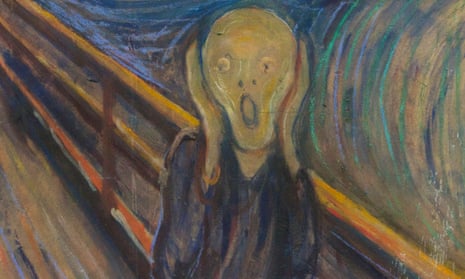After years of speculation, scientists from the University of Antwerp in Belgium have finally solved a mystery surrounding The Scream, Edvard Munch’s iconic painting. A strange white mark on one version of the painting has been identified as candle wax, and not bird droppings as was once theorized.
Munch painted four versions of the artwork during the 1890s, but an 1893 iteration which resides in the Norwegian National Museum has long had a white smudge of unknown origin near the screaming subject’s shoulder. One version sold for $119,922,500 in 2012 and hung in the Museum of Modern Art in New York for a time. Two others belong to the Munch Museum. One was once stolen, as were some of the artist’s other works – though they were later recovered.
As photographs show that Munch sometimes painted outside and “liked to expose his paintings to the forces of nature”, some theorized that “birds flying by literally added another layer of meaning to Munch’s Masterpiece”, a spokesperson for the University of Antwerp wrote on its site.
Professor Tine Frøysaker from the University of Oslo and Thierry Ford, paintings conservator at the National Museum, however, were unconvinced. Frøysaker, who has encountered bird excrement in other aspects of her career, thought the white spot did not look like bird droppings under the microscope. According to the university’s post, Ford believed that “bird excrements are known to have a corroding or macerating effect on many materials, a statement that most car owners can confirm”, and the substance on Munch’s painting seemed to lie on top of the paint and to have flaked off throughout the years.
“A last technical argument opposing this theory is the fact that Munch employed a cardboard substrate to paint the Scream, a material that is particularly fragile and hygroscopic and would have suffered severe damage when left outdoors,” the spokesperson for the University of Antwerp wrote.
Last May, a team of researchers from Antwerp’s X-ray Analysis, Electrochemistry and Speciation research group were invited to Oslo to analyze the materials used in The Scream and used the opportunity to settle the dispute.
The researchers took a sample of the substance and analyzed it using X-ray diffraction. “I immediately recognised the diffraction pattern of wax as I encountered this material several times upon measuring paintings,” Frederik Vanmeert, a PhD student at Antwerp, said.
Dr Geert van der Snickt collected a sample of excrement to test in an effort to further disprove the bird droppings theory. “I must admit I was a little embarrassed collecting this sample material in front of groups of tourists,” he said. The X-ray diffraction pattern of the sample matched the wax, and not the bird droppings. Van der Snickt acknowledged that “the composition of droppings is strongly dependent on the nutrition of the bird, but I sincerely doubt that Munch’s painting was sprayed by birds that happened to be fond of wax”.
The researchers believe that the white spots on The Scream came from a dripping candle in Munch’s studio. “I think we can close the case on the bird droppings,” they wrote.
The case of the white smudge is one of a few painting mysteries which have been solved this month. The artist Peter Doig recently won a court case proving that he did not paint a landscape signed “Peter Doige”. X-ray fluorescence was used to identify another face beneath Edgar Degas’s Portrait of a Woman as Emma Dobigny, one of the impressionist’s favored French models.
- This article was amended on 31 August 2016 to clarify that the version of The Scream that sold in 2012 no longer hangs in the Museum of Modern Art.

Comments (…)
Sign in or create your Guardian account to join the discussion